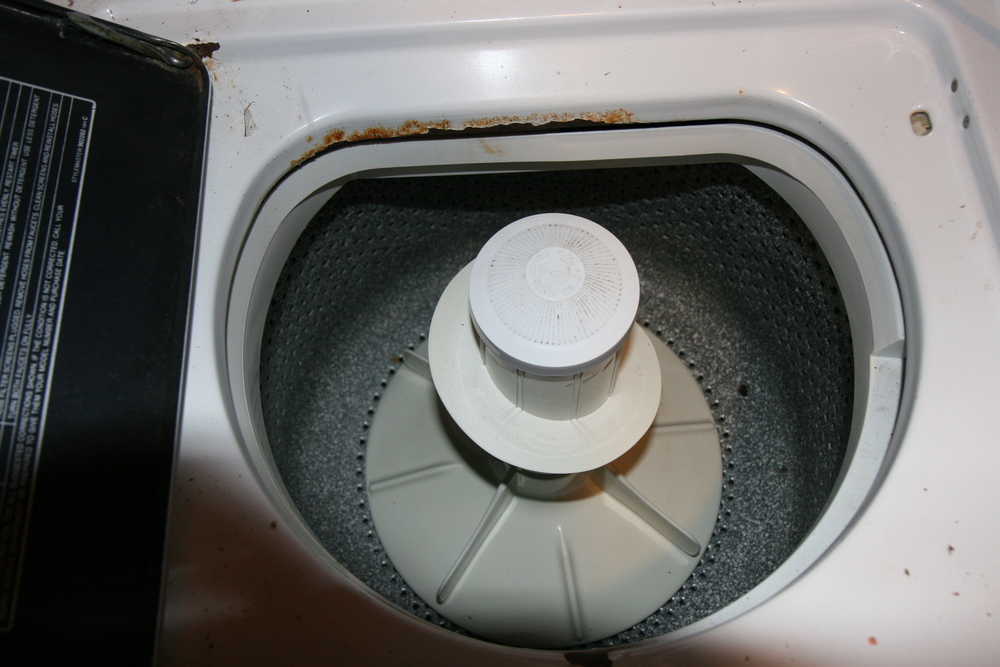|
Thread Number: 19427
/ Tag: Vintage Automatic Washers
Long live the Roto - Swirl! |
[Down to Last] |

|
Post# 312701 , Reply# 1 11/2/2008 at 08:53 (5,651 days old) by appnut  (TX) (TX) |
||
|
They seem like they are built so that you can overload a mac
From what I understand, that's a lot of why they were introduced--especially with the new extra large or super capacity washers at the time from Kenmore. I can tell you from personal experience that the penta-vane and penta-swirl just didn't move large loads around all that well. I'm hoping Magic Clean will chime in on this discussion. I believe they were finding people were really stuffing these new extra large capacity machines when they could and the loads just weren't moving around. And as time went on the driect drive mechanism was introduced mainly to offer a lower-cost, easier to produce mechanism. The shorter, faster stroke, coupled with the dual-action tye of agitator, moved clothes around even better for those really large loads.
| ||
Post# 312704 , Reply# 2 11/2/2008 at 09:06 (5,651 days old) by kenmoreguy64  (Charlotte, NC) (Charlotte, NC) |
||

The Roto-Swirl, although there was a large capacity version for a few years until the mid 70s, was primarily a standard tub agitator. The large capacity machines, that Sears first called 'Jumbo' capacity, are the models in which the Dual-Action earned it's keep. There are some specific challenges in moving clothes from the top of a large tub to the bottom which a standard agitator doesn't have to contend with. These large capacity models were quoted to be 38% larger. That is translated from being several inches wider in diameter, and three inches taller. That may not seem like a lot of difference, but it is massive. In the 1980 and older models, a standard Roto-Swirl is too shallow and can get overwhelmed (water would rise to the very top). Most of us here know better than to overload a machine, but the DA was designed to address the average user's propensity to do that. The large capacity version of the Roto-Swirl was a basic super Roto on Steroids, but the machines used transmissions with the same internal parts. Sears and Whirlpool found out that the drag caused by the massive agitators and a heavy load of laundry could prematurely damage or wear the transmission, so agitators that could fit the big tub, not damage the trans, yet still be effective had to be designed. That is how the Penta-Vane and Penta-Swirl came to be. These agitators have five shallow vanes (less drag) vs. the original three taller ones of the big Roto-Swirl. These agitators also allow a common agitator shaft to be used between all models. Those two agitators were considered OK unless a user stuffed the machine, so the DA was developed to help move clothes from the stratosphere of the tub down to the vanes. We never complained about the Penta-Vane in our 1974 Kenmore, but my mom and I are not overloaders. I didn't like the DA in our 1983 Kenmore at first because of its lack of convention, but I came to admit and agree that they do a noticeably better job in keeping full loads mobile in those big tubs. The DA has four flexible vanes, which have some "give" to them which helps with the big-tub transmission stress. A DA doesn't do much good unless the machine is on high water level and full of laundry, but that's where it shines. There was a standard tub DA, but they were not common and probably nowhere near as necessary, since you're right - the Roto-Swirl was sufficient in a standard tub machine. I recently acquired two standard tub DA machines - one has a 1976 ratchet style design, the other a later one. Eventually I'll find out if these models offer any benefits over a Roto-Swirl or Straight Vane. | ||
| Post# 312711 , Reply# 3 11/2/2008 at 11:23 (5,651 days old) by tuthill () | ||
|
Gordon I just love it when you share your vast and expansive Kenmore knowldege. It's fascinating. As far as the standard cap DA's are concerned, I got one!!! 
| ||
Post# 312726 , Reply# 4 11/2/2008 at 12:45 (5,651 days old) by kenmoreguy64  (Charlotte, NC) (Charlotte, NC) |
||

I'm blushing Jed, but THANKS! You not only have a standard capacity DA there, but I'm guessing it's in a 24-inch machine, am I right? Those tubs are a tad smaller than a standard tub, so the DA must be a monster in it. The easiest way to discern a standard DA from a big-tub version is to look at the top of the auger. It tapers out from the top on the standard tub, whereas in the more common big-tub, it protrudes out immediately. With the agitator shaft so high out of the basket in a standard machine, I'm wondering how much of the auger is actually underwater in a full tub, since I've never seen one of these in action. Is that the machine you posted about earlier in the late spring or so? I have wondered what became of it and the Hotpoint/GE after you got into the cool heavy iron after that. G | ||
Post# 312733 , Reply# 6 11/2/2008 at 13:11 (5,651 days old) by kenmoreguy64  (Charlotte, NC) (Charlotte, NC) |
||

This upcoming winter will hopefully bring some washer play-time for me. This summer I managed to resurrect two Penta-Swirl machines, a coule Penta-Vane models, one with a Vari-Flex, and a couple Straight Vanes. I have a nearly new Roto-Swirl to go into the '76 with the broken ratchet DA, plus the '61 I just got, so I think I have the bases covered. :-) I used the heck out of one of the straight vane machines this summer, and I couldn't figure out why Sears considered that the entry level agitator, as it can move some clothes! Granted I don't overload.....It can also get a joyous observer really soaked if on anything other than a High water level. I have never paid much attention to a Penta-Swirl other than when I fixed a machine with one in it. It was supposed to be the "roto-swirl" for the big tubs, but I think and have heard here as well that the Penta-Vane may actually be more effective. We never had a problem with our Penta-Vane, but I do remember things not moving so much if we had a machine full of towels. Sears offered a DA retro-fit kit for previous Penta models, and I tried more than once to get my Mom to buy one - she wouldn't consider it. Later when we moved to NC and got the 1983 Kenmore, I exclaimed "that's the agitator I wanted you to try!". | ||
Post# 312810 , Reply# 10 11/2/2008 at 18:34 (5,651 days old) by kenmoreguy64  (Charlotte, NC) (Charlotte, NC) |
||

Jed - The "canister thing" you're talking about is called by many servicers the 'button trap'. Whirlpool calls it a manifold assembly, and it's purpose is to protect the pump from debris. I have seen MANY with pins in them that were left in new clothes. Those pins could have damaged or locked-up a pump. I have also found coins in the traps. The manifold was put into service sometime between 1957 and 1961, and as far as I know was included on every belt drive washer made once it debuted. There could be a freeze crack in your manifold, or the hose leading to it could be leaking. The tub outlet hose that the manifold attaches to is a somewhat common source of leaks. The outlet hose is seated in the baseplate under the tub. When secured by the four mounting screws, the tub compresses the hose and makes a seal. The hose for your machine is still available new and not expensive. You get the joy of pulling the outer tub to change the hose, but that's good education anyway and you can change the centerpost gasket at the same time, another source of leaks. I'm glad the machines will be there for your enjoyment later on! | ||
Post# 312813 , Reply# 11 11/2/2008 at 18:41 (5,651 days old) by kenmoreguy64  (Charlotte, NC) (Charlotte, NC) |
||

Matt - I don't think a gimic would last in production for more than a quarter century and be copied by nearly every other domestic manufacturer as soon as patent law allowed. I see your logic, but the DA helps ensure that a large load gets more uniformly turned over. In your scenario some parts of the load could wind up spending more than their "fair share" of time in the wash zone. The DA simply helps keep things moving. | ||
| Post# 313062 , Reply# 12 11/4/2008 at 11:40 (5,649 days old) by laundromat (Hilo, Hawaii) | ||
Jet Cone Agitator by FRIGIDAIRE
I truly believe that the entire idea of the DualAction Agitator was to be more competitive with FRIGIDAIRE'S Jet Cone Agitator.The fact that not only that style but the Three-Ring Agitator as well as the Deep Action Agitator wer much more effective in turn-over of the clothes. Top to bottom,bottom to top over and over again.No beating,pounding or pulling. Just surging currents of water through the clothes.You were able to wash more clothes using less water per Square inch than any other brand.The only other huge capacity machines that did anywhere near as well in turn-over and water extraction were the Norge line as well as their subsidieries.Their(Norge and Frigidaire) wash tubs were almost identical.Once Sears released their DualAction and KMart began carrying Frigidaire appliances,that was the beginning of the end.
| ||
Post# 313073 , Reply# 13 11/4/2008 at 13:15 (5,649 days old) by kenmoreguy64  (Charlotte, NC) (Charlotte, NC) |
||

Chuck, I see the situation a little differently. When Kenmore introduced the DA in the fall of 1975 as part of the new 1976 line-up, they included it in two models. By 1977 and 1978, it had spread through the line considerably each year. Kenmore's introductory advertisements both in television and in print compared a DA equipped machine to three other no-name generic machines, saying they were the top competitors. A knowledgeable observer can tell the generics were a Whirlpool, a GE, and a Maytag. Frigidaire was certainly a market player back in the mid-70s, but if this brand was Kenmore's target, it would have clearly been compared to as part of the major advertising focus. Kenmore already had the largest market share. I think rather than targeting specifically Frigidaire or any one brand, they were trying to counter perceived weakness in their own line (with the 'Pentas) and further cement themselves as the market leader by having something else that the competition could not, by patent, offer for quite some time. | ||
Post# 313077 , Reply# 14 11/4/2008 at 13:24 (5,649 days old) by kenmoreguy64  (Charlotte, NC) (Charlotte, NC) |
||
On the other hand....
Frigidaire clearly considered Kenmore a major challenge. This is what lead them to produce that now famous commercial which compared a Frigidaire 1-18 and it's turnover to "their best washer", which was a Kenmore with a Dual-Action. The funny part is the premise was that only Kenmore's best machine had that agitator, which was never really true and by the next year (the ad kept running) it was more widely available.
| ||
Post# 313089 , Reply# 15 11/4/2008 at 14:26 (5,649 days old) by neptunebob  (Pittsburgh, PA) (Pittsburgh, PA) |
||
 | ||

 Comes to the Rescue!
Comes to the Rescue!